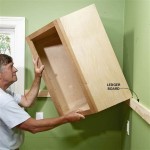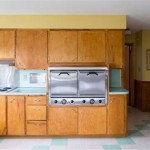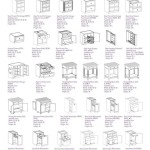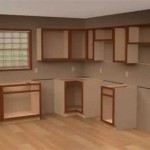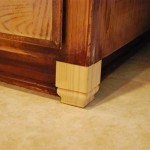How To Keep Cabinet Liner In Place
Cabinet liners serve a vital function in maintaining the cleanliness and longevity of kitchen, bathroom, or utility cabinets. They act as a barrier against spills, crumbs, and moisture, preventing damage to the cabinet's interior surfaces. However, achieving their full potential requires the liner to stay firmly in place. A shifting or bunching liner not only negates its protective qualities but also becomes a nuisance, requiring constant readjustment. This article details effective methods for securing cabinet liners and preventing them from moving.
Proper Measurement and Cutting: The Foundation for a Secure Fit
The first and often most crucial step in ensuring a cabinet liner stays put is precise measurement and cutting. A liner that is too short will leave areas unprotected, while one that is too long will bunch up and create uneven surfaces. Accurate dimensions are the bedrock of a stable and functional liner.
Begin by thoroughly cleaning the interior surface of the cabinet. Remove any debris, crumbs, or spills and allow the surface to dry completely. Then, using a measuring tape, determine the precise width and depth of the cabinet shelf or drawer bottom that will be lined. It's advisable to measure at multiple points, as cabinet interiors may not always be perfectly square.
Transfer the measurements to the liner material. Using a straight edge and a sharp utility knife or scissors, carefully cut the liner to the determined size. Precision is key here. Aim for a snug fit, but avoid cutting the liner too large, which can cause it to buckle or ripple. A slightly undersized liner is preferable to one that is too big.
For cabinets with irregular shapes or obstructions, such as plumbing pipes, create a template using paper or cardboard. Place the template inside the cabinet and trace the outline of the obstruction. Transfer this outline to the liner and carefully cut out the necessary shape. This ensures a seamless fit around any obstacles.
Employing Adhesives: Temporary and Semi-Permanent Solutions
Various adhesive options are available to secure cabinet liners, ranging from temporary to semi-permanent solutions. The choice of adhesive depends on personal preference, the type of liner material, and the desired level of permanence. It's essential to select an adhesive that will not damage the cabinet's finish.
Non-Adhesive Grip Liners: These liners are typically made from textured materials, such as rubber or vinyl, that provide inherent grip. While they don't rely on adhesives, their effectiveness depends on the weight of the items placed on them. For lighter items or high-traffic cabinets, additional anchoring may be needed.
Double-Sided Tape: This is a popular and relatively non-permanent option. Choose a thin, strong double-sided tape specifically designed for household use. Apply small strips of tape along the edges and corners of the liner, as well as in the center for larger surfaces. Press the liner firmly onto the cabinet surface, ensuring good contact with the tape. Double-sided tape allows for easy removal and repositioning when needed.
Adhesive Shelf Liners: These liners come with a pre-applied adhesive backing. While offering a more secure hold, they are generally considered a semi-permanent solution. Carefully peel off the backing paper and align the liner with the cabinet surface. Press firmly, working from one edge to the other to avoid air bubbles. Once adhered, these liners are more difficult to remove without potentially damaging the cabinet finish.
Spray Adhesive: A light coating of spray adhesive can provide a more even and consistent hold compared to double-sided tape. Choose a repositionable spray adhesive designed for delicate surfaces. Apply a thin, even coat to the back of the liner, following the manufacturer's instructions. Allow the adhesive to become slightly tacky before positioning the liner in the cabinet. This method provides a stronger hold but can be messy and requires good ventilation.
Caution Regarding Permanent Adhesives: Avoid using strong, permanent adhesives, such as construction adhesive or super glue. These adhesives can cause irreversible damage to the cabinet surface and make liner removal extremely difficult. They are generally not recommended for cabinet liner installation.
Weight Distribution and Strategic Placement of Items
Even with adhesives, the placement of items within the cabinet can significantly impact the stability of the liner. Uneven weight distribution or the placement of heavy items near the edges can cause the liner to shift or lift over time. Strategic placement of items helps to maintain the liner's position and prevent movement.
When organizing the cabinet, distribute weight evenly across the surface of the liner. Avoid concentrating heavy items in one area. Place heavier items towards the center of the shelf or drawer, where the liner is less likely to lift or buckle. Lighter items can be placed towards the edges.
Consider using storage containers or organizers to help distribute weight and prevent items from directly contacting the liner. These containers can also provide additional stability and prevent items from sliding around, which can contribute to liner movement. Choose containers that are appropriately sized for the cabinet and the items they will hold.
Regularly check the cabinet liner for any signs of shifting or lifting. If necessary, readjust the placement of items to redistribute weight and prevent further movement. Addressing minor issues early on can prevent more significant problems later.
In high-traffic cabinets or those containing frequently used items, consider using additional supports to reinforce the liner's position. Small pieces of double-sided tape or adhesive putty can be placed under heavy items to prevent them from shifting and pulling on the liner. These supports provide additional stability and help to maintain the liner's position over time.
For drawers, consider using drawer dividers to create compartments and prevent items from rolling around. These dividers not only help with organization but also provide additional support for the liner, preventing it from shifting or bunching up. Choose dividers that are appropriately sized for the drawer and the items they will hold.
Furthermore, the type of items being stored can influence the choice of liner material. Heavier objects may benefit from thicker, more durable liners. Items that are prone to leaking or condensation may require liners with water-resistant properties. Matching the liner material to the contents of the cabinet can enhance its effectiveness and longevity.
Finally, cleaning spills promptly is crucial. Spills can seep under the liner, weakening the adhesive and causing it to lift. Regular cleaning and maintenance will extend the life of the liner and keep it securely in place.

Simple Diy Drawer And Shelf Liners

Why You Need Shelf Liner Cleaning Organizing S Blue I Style

Why You Need Shelf Liner Cleaning Organizing S Blue I Style

Simple Diy Drawer And Shelf Liners

Simple Diy Drawer And Shelf Liners

Why You Need Shelf Liner Cleaning Organizing S Blue I Style

Making Things Pretty Drawer Shelf Liners The Inspired Room
How To Line Drawers Perfectly Using Double Sided Tape

Shelf Liners For Kitchen Cabinets Drawers A How To Guide Diy

How To Keep Kitchen Cabinets Drawers Looking Fresh Duck Brand

